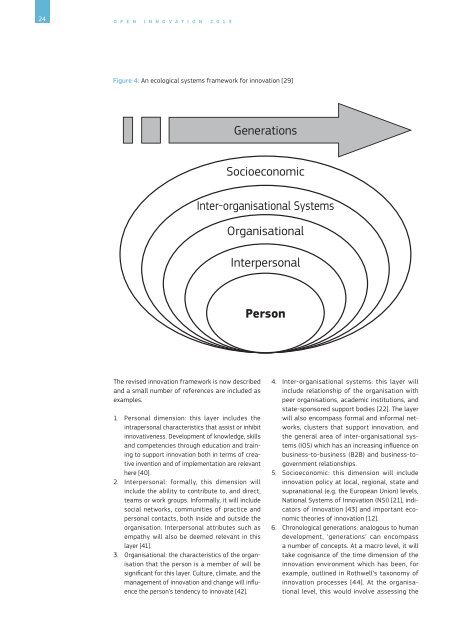Open Innovation 2.0 Yearbook 2013 - European Commission - Europa
Open Innovation 2.0 Yearbook 2013 - European Commission - Europa
Open Innovation 2.0 Yearbook 2013 - European Commission - Europa
You also want an ePaper? Increase the reach of your titles
YUMPU automatically turns print PDFs into web optimized ePapers that Google loves.
24 O P E N I N N O V A T I O N 2 0 1 3<br />
Figure 4: An ecological systems framework for innovation [29]<br />
The revised innovation framework is now described<br />
and a small number of references are included as<br />
examples.<br />
1. Personal dimension: this layer includes the<br />
intrapersonal characteristics that assist or inhibit<br />
innovativeness. Development of knowledge, skills<br />
and competencies through education and training<br />
to support innovation both in terms of creative<br />
invention and of implementation are relevant<br />
here [40].<br />
2. Interpersonal: formally, this dimension will<br />
include the ability to contribute to, and direct,<br />
teams or work groups. Informally, it will include<br />
social networks, communities of practice and<br />
personal contacts, both inside and outside the<br />
organisation. Interpersonal attributes such as<br />
empathy will also be deemed relevant in this<br />
layer [41].<br />
3. Organisational: the characteristics of the organisation<br />
that the person is a member of will be<br />
significant for this layer. Culture, climate, and the<br />
management of innovation and change will influence<br />
the person’s tendency to innovate [42].<br />
Generations<br />
Socioeconomic<br />
Inter-organisational Systems<br />
Organisational<br />
Interpersonal<br />
Person<br />
4. Inter-organisational systems: this layer will<br />
include relationship of the organisation with<br />
peer organisations, academic institutions, and<br />
state-sponsored support bodies [22]. The layer<br />
will also encompass formal and informal networks,<br />
clusters that support innovation, and<br />
the general area of inter-organisational systems<br />
(IOS) which has an increasing influence on<br />
business-to-business (B2B) and business-togovernment<br />
relationships.<br />
5. Socioeconomic: this dimension will include<br />
innovation policy at local, regional, state and<br />
supranational (e.g. the <strong>European</strong> Union) levels,<br />
National Systems of <strong>Innovation</strong> (NSI) [21], indicators<br />
of innovation [43] and important economic<br />
theories of innovation [12].<br />
6. Chronological generations: analogous to human<br />
development, ‘generations’ can encompass<br />
a number of concepts. At a macro level, it will<br />
take cognisance of the time dimension of the<br />
innovation environment which has been, for<br />
example, outlined in Rothwell’s taxonomy of<br />
innovation processes [44]. At the organisational<br />
level, this would involve assessing the
















